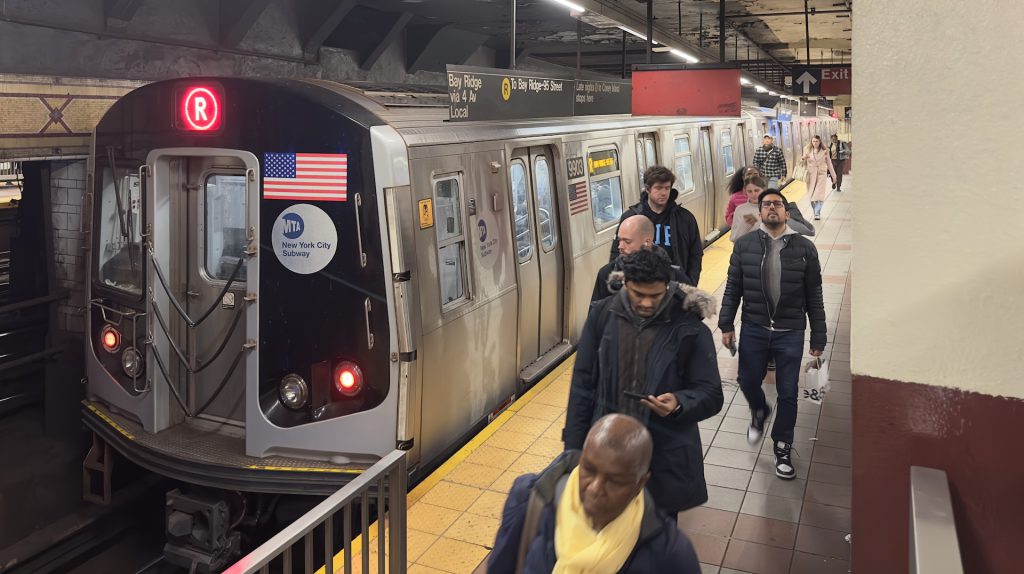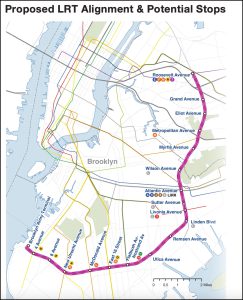
With 23.3% of students traveling from Brooklyn and 23.5% traveling from Queens, the Interborough Express (IBX) might have been a potentially new addition to Hunter College students’ plethora of ways to travel around the city. The reality of the project, however, suggests that the project won’t be as universally helpful to students as is proposed if it even gets funded.
So, given the proposition of the IBX’s existence, let us discuss some of the light rail’s pros and cons and its real-world feasibility.

What is the IBX?
The IBX is a proposed light rail from Bay Ridge’s Brooklyn Army Terminal to Roosevelt Avenue on the E, F, M, R, & 7 lines. The line derives from another project known as The Triboro, which would have continued this line into Co-Op City in the Bronx. Although, there are considerations of extending it into the Bronx and to LaGuardia Airport.
According to The MTA, the project is projected to cost $5.5 billion, with a projected weekly ridership of 155,000. As of January 2024, Governor Kathy Hochul had announced $45 million towards the project, and the line was included in the MTAs 2025-2029 Capital Program.
How will the IBX benefit students?
Unless a student lives in areas of eastern Brooklyn where the line would travel, the line is unlikely to have implications for students. The IBX goes between Brooklyn and Queens. Two Hunter College students, Chinara Amaukwu and Efraim Aloni, both stated that it doesn’t help them despite being deep within the city. “I mean, unless I’m traveling to those areas, I’m not gonna be using [the IBX],” Amaukwu said. Aloni mirrored that message, saying, “I don’t think that it would go near my house even, probably, because if it’s, like, that Queens, that’s not where I live in Queens.”
Urban Science Professor and author Nicholas Dagen Bloom also suggested that the project is more geared towards the growing business hubs of Brooklyn rather than necessarily ease of travel. As it stands, the current center of the MTA is business-filled Manhattan, so the IBX could function to work for outer-borough business centers. But like Aloni and Amaukwu, he doesn’t think the line would function unless there is enough density and demand.
It seems that the IBX would be of limited support for Hunter students as it still requires multiple trains or simply doesn’t pass the neighborhood that an individual would need.
What are some of the setbacks that the IBX faces?
Funding is one of the biggest drawbacks of the IBX. The MTA is currently struggling. According to Bloomberg, the 2025-2029 Capital Project proposed by the MTA faces a $27 Million gap. There is also a preexisting deficit of $15 million because of Kathy Hochul’s cancellation of congestion pricing in New York City.
The line would go through neighborhoods such as East New York, which are only served by buses, allowing for a new train line, but it isn’t enough. “Rectifying the disparity of access would take more than 60 miles of new subway track and over 40 new subway stations, according to the Regional Plan Association,” reported the New York Times in 2017.
Dagen-Bloom also said that the IBX was not the MTA’s highest priority because of monetary issues and a preference to work on the Second Avenue Subway Extension. Professor Dagen Bloom echoed these reports. “If the governor comes through with congestion pricing, it could go through.” He explained.
Individuals at Hunter have also mentioned that critical maintenance work needs to be done before this city sees new lines. “The MTA is currently very unorganized, and their apps are all over the place, and like, their timing is not right, and everything is broken, and I think that we should throw our money at fixing the subways and making them accessible to people, and making them not either super hot or super cold, and not make them flood every time it drizzles, and not make buses just too hot” Aloni, the student, said. Former Transit President Richard Davey told The Gothamist that the IBX should take a backseat for more pressing matters to be addressed.
It seems that the idea is a start, but it won’t solve everything. Funding is also imperative in the IBX’s construction, which the MTA struggles with. Individuals also believe that it would be better to address the system’s current problems first than look to add to the system.









